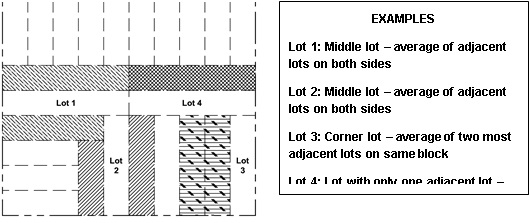New Orleans Comprehensive Zoning Ordinance
Printed: 4/23/2024 11:01:54 PM
16.3 Bulk and Yard Regulations
16.3.A Site Design Standards
16.3.A.1 General Regulations
Table 16-2: Bulk and Yard Regulations establishes bulk and yard regulations for the Centers of Industry Districts.
Table 16-2: Bulk & Yard Regulations
| Table 16-2: Bulk & Yard Regulations |
|
BULK & YARD REGULATIONS
|
DISTRICTS
|
|
LI
|
HI
|
MI
|
BIP
|
|
BULK REGULATIONS
|
|
|
MINIMUM
LOT AREA
|
5,000sf
|
10,000sf
|
10,000sf
|
5,000sf
|
|
A
|
MAXIMUM BUILDING HEIGHT
|
75’, unless adjacent to a residential district then 50’ but may exceed 50’ if set back 1’ for each foot above 50’ up to 75’
|
None, unless adjacent to a residential district then 50’ - may exceed 50’ if set back 1’ for each foot above 50’
|
None, unless adjacent to a residential district then 50’ - may exceed 50’ if set back 1’ for each foot above 50’
|
75’, unless adjacent to a residential district then 50’ but may exceed 50’ if set back 1’ for each foot above 50’ up to 75’
|
| |
MINIMUM PERMEABLE OPEN SPACE |
20% of the lot area |
20% of the lot area |
20% of the lot area |
20% of the lot area |
|
MINIMUM YARD REQUIREMENTS
|
|
B
|
FRONT YARD
|
Section 16.3.A.2
|
Section 16.3.A.2
|
Section 16.3.A.2
|
Section 16.3.A.2
|
|
C
|
INTERIOR
SIDE YARD
|
15’
|
20’
|
20’
|
None, unless lot abuts residential district then 10’
|
|
D
|
CORNER
SIDE YARD
|
10’
|
20’
|
20’
|
None
|
|
E
|
REAR YARD
|
None, unless abutting residential district, then 20’
|
None, unless abutting a residential district, then 20’
|
20’, unless rear yard abuts a waterway, then none required
|
None, unless lot abuts residential district then 20’
|
TABLE 16-2 FOOTNOTES
1 If a property abuts more than one zoning district, the more restrictive yard requirement applies.

Adopted by Ord. No. 26,726, §1, December 7, 2015, Zoning Docket 081/15; Ord. No. 27,722, §7, April 11, 2018, Zoning Docket 113/17
16.3.A.2 Front Yard Build-To Line Requirement
a. Within the Centers for Industry Districts, the front yard build-to line is established by any one (1) of the following methods. A build-to line is an established setback line at which a structure is required to build. However, in no case may the front yard exceed twenty (20) feet.
i. As of the effective date of this Ordinance, the current front yard of the existing structure may be set as the required front yard build-to line. When a structure is demolished, the demolition permit shall indicate the dimension of the front yard prior to demolition. The required front yard build-to line is that indicated on the demolition permit.
ii. The required front yard build-to line indicated on the most recent survey or Sanborn maps.
iii. The average of the front yard of the adjacent lots on either side may be used to establish the required front yard build-to line. Averaging is based on the two (2) adjacent lots or, in the case of a corner lot, two (2) neighboring lots on the same blockface. In the case of a lot configuration where only one (1) lot is available for averaging, the front yard build-to line is that of the adjacent lot. (See Figure 16-1: Front Yard Averaging)
b. The applicant is permitted a plus or minus three (3) foot variation from a front yard build-to line established by any of the above methods.
c. The required front yard build-to line is measured as the narrowest dimension from the front lot line to the principal structure. The measurement is taken from the building walls of the principal structure and does not include permitted encroachments or architectural features.
FIGURE 16-1: FRONT YARD AVERAGING

16.3.B Building Design Standards
1. The following standards shall apply to all sites except those buildings or portions thereof that are not visible from the public right-of-way.
a. Nearly vertical roofs (A-frames) and piecemeal mansard roofs used on a portion of the building perimeter are prohibited.
b. Reflective roof materials that produce glare are prohibited.
2. The following standards shall apply to all sites that meet the applicability thresholds of Section 4.5 Development Plan and Design Review:
a. Buildings shall use decorative roof elements, such as projecting cornices, to define building entrances, main pedestrian routes, or activity areas.
b. Green roof, blue roof, and white roof designs are encouraged.
c. In the LI and BIP Districts, multi-building complexes shall develop a comprehensive architectural concept within a campus-like design. Various site components shall be unified through the use of similar design features, construction, material, and colors. Buildings within such complexes shall be compatible in height and scale.
d. The design of accessory structures, such as security kiosks, maintenance buildings, and outdoor equipment enclosures, shall be incorporated into and compatible in design with the overall design of the project and the principal buildings on the site.
16.3.B.3 Building Materials
a. The following materials are prohibited as the predominant surface finish material on exterior elevations visible from the public right-of-way. However, such materials may be used as part of decorative or detail elements, or as part of the exterior construction that is not used as a predominant surface finish material.
i. EIFS panels
ii. Stuccato Board
iii. Vinyl